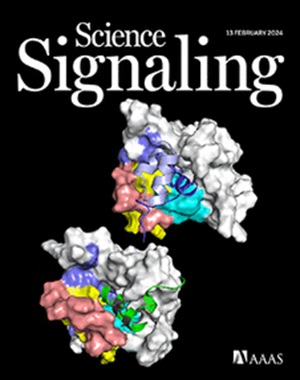YAP controls cell migration and invasion through a Rho GTPase switch
IF 6.6
1区 生物学
Q1 BIOCHEMISTRY & MOLECULAR BIOLOGY
Science Signaling
Pub Date : 2025-05-27
引用次数: 0
Abstract
Delineating the mechanisms that control the movement of cells is central to understanding diverse physiological and pathophysiological processes. The transcriptional coactivator YAP is important during development and associated with cancer metastasis. Here, we found that YAP promoted cell migration by modulating a Rho family guanosine triphosphatase (GTPase) switch involving Rac1 and RhoA, which are key regulators of cytoskeletal dynamics. YAP transcriptionally transactivated the gene encoding the Rac1 guanine nucleotide exchange factor TRIO by directly binding to its intronic enhancer. This led to the activation of Rac1 and inhibition of RhoA, which increased cell migration and invasion in vitro and in vivo. This YAP-dependent program was observed across many cell types, including human breast epithelial cells and astrocytes, but it was particularly enhanced in a patient-specific manner in glioblastoma (GBM), the most common malignant brain tumor. Additionally, YAP-TRIO signaling activated STAT3, a transcription factor implicated in invasive growth in cancer, suggesting potential for cross-talk with this pathway to exacerbate invasive behavior. Clinically, hyperactivation of YAP, TRIO, and STAT3 gene signatures in GBM were associated with poor survival outcomes in patients. Our findings suggest that the YAP-TRIO-Rho-GTPase signaling network regulates invasive cell spread in both physiological and pathological contexts.

YAP通过Rho GTPase开关控制细胞迁移和侵袭
描述控制细胞运动的机制是理解各种生理和病理生理过程的核心。转录辅激活因子YAP在肿瘤发育过程中起重要作用,并与肿瘤转移有关。在这里,我们发现YAP通过调节Rho家族鸟苷三磷酸酶(GTPase)开关来促进细胞迁移,该开关涉及Rac1和RhoA,这是细胞骨架动力学的关键调节因子。YAP通过直接结合内含子增强子转录反激活了编码Rac1鸟嘌呤核苷酸交换因子TRIO的基因。这导致了Rac1的激活和RhoA的抑制,从而增加了细胞在体外和体内的迁移和侵袭。这种依赖于yap的程序在许多细胞类型中都被观察到,包括人类乳腺上皮细胞和星形胶质细胞,但在最常见的恶性脑肿瘤胶质母细胞瘤(GBM)中,它以患者特异性的方式被特别增强。此外,YAP-TRIO信号激活了STAT3,这是一种与癌症侵袭性生长有关的转录因子,表明与该途径的串扰可能会加剧侵袭性行为。在临床上,GBM中YAP、TRIO和STAT3基因信号的过度激活与患者的不良生存结果相关。我们的研究结果表明,YAP-TRIO-Rho-GTPase信号网络在生理和病理背景下调节侵袭性细胞的扩散。
本文章由计算机程序翻译,如有差异,请以英文原文为准。
求助全文
约1分钟内获得全文
求助全文
来源期刊

Science Signaling
BIOCHEMISTRY & MOLECULAR BIOLOGY-CELL BIOLOGY
CiteScore
9.50
自引率
0.00%
发文量
148
审稿时长
3-8 weeks
期刊介绍:
"Science Signaling" is a reputable, peer-reviewed journal dedicated to the exploration of cell communication mechanisms, offering a comprehensive view of the intricate processes that govern cellular regulation. This journal, published weekly online by the American Association for the Advancement of Science (AAAS), is a go-to resource for the latest research in cell signaling and its various facets.
The journal's scope encompasses a broad range of topics, including the study of signaling networks, synthetic biology, systems biology, and the application of these findings in drug discovery. It also delves into the computational and modeling aspects of regulatory pathways, providing insights into how cells communicate and respond to their environment.
In addition to publishing full-length articles that report on groundbreaking research, "Science Signaling" also features reviews that synthesize current knowledge in the field, focus articles that highlight specific areas of interest, and editor-written highlights that draw attention to particularly significant studies. This mix of content ensures that the journal serves as a valuable resource for both researchers and professionals looking to stay abreast of the latest advancements in cell communication science.
 求助内容:
求助内容: 应助结果提醒方式:
应助结果提醒方式:


